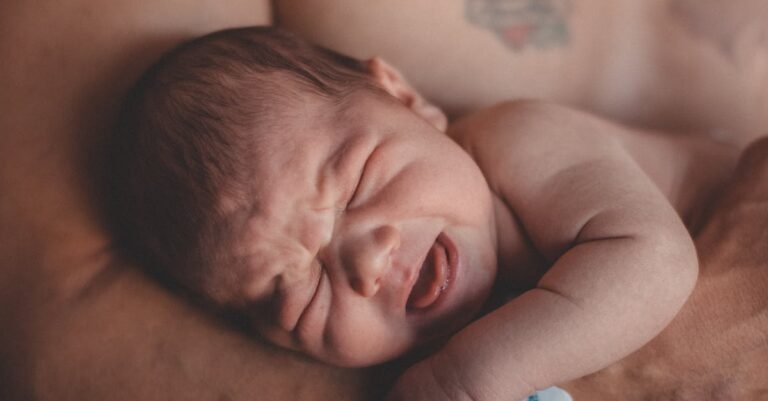Every parent knows the struggle of getting their little one to sleep. It often feels like a scene from a suspense thriller, where the hero (the baby) battles against the forces of sleep. Enter baby soothing sleep aids—the ultimate sidekicks in this nightly adventure. From white noise machines that mimic the comforting sounds of the womb to swaddles that hug like a gentle bear, these tools can turn bedtime chaos into a peaceful slumber.
Imagine a world where your baby drifts off to dreamland with ease, leaving you to enjoy a well-deserved moment of peace. With the right soothing aids, parents can reclaim their evenings and possibly even catch up on that elusive sleep themselves. Dive into the world of baby soothing sleep aids and discover how these clever inventions can transform bedtime into a breeze, making both baby and parent happy campers.
Table of Contents
ToggleOverview of Baby Soothing Sleep Aids
Baby soothing sleep aids serve as essential tools for parents seeking to promote better sleep for their infants. These aids create a calming environment that facilitates relaxation and sleep.
Importance of Sleep for Babies
Sleep plays a vital role in a baby’s growth and development. During sleep, babies process new information and experience crucial brain growth. Lack of adequate sleep can lead to irritability, developmental delays, and health issues. Newborns require 14 to 17 hours of sleep daily, while older infants need about 12 to 15 hours. Consistent sleep patterns contribute to better mood regulation and cognitive function. Prioritizing quality sleep ensures that babies thrive both physically and emotionally.
Common Sleep Challenges
Parents often face multiple challenges when it comes to their baby’s sleep. Frequent awakenings disrupt both babies and parents, leading to exhaustion. Colic, teething, and environmental factors can also hinder peaceful sleep. Some babies struggle with self-soothing abilities, requiring external aids. Crankiness and overstimulation can further complicate bedtime routines. Identifying these challenges allows parents to select appropriate soothing sleep aids that address their baby’s specific needs.
Types of Baby Soothing Sleep Aids
Parents can choose from several effective tools designed to help babies sleep better. Exploring each type provides insight into their unique benefits.
White Noise Machines
White noise machines produce soothing sounds that create a calming environment for babies. These devices mask disruptive noises, helping infants remain undisturbed during sleep. Many experts suggest using white noise between 50 and 60 decibels to mimic prenatal sounds. Popular options include various settings, from gentle rainfall to ocean waves. With consistent white noise, some babies learn to fall asleep more easily.
Swaddles and Sleep Sacks
Swaddles and sleep sacks provide a secure feeling for infants by mimicking the womb’s embrace. When swaddled properly, babies often feel more comfortable and less startle when sleeping. Several types, like adjustable or zipper models, cater to different preferences. Sleep sacks offer versatility by allowing for free movement of arms or legs, which can enhance comfort. Many parents notice reduced fussiness when using these helpful sleep aids.
Pacifiers
Pacifiers serve dual purposes: soothing infants while promoting self-soothing skills. When babies suck on a pacifier, they often feel relaxed, which can aid in falling asleep. Research indicates that pacifier use during sleep may lower the risk of Sudden Infant Death Syndrome (SIDS). Various styles exist, including orthodontic designs to support developing mouths. Parents often find that keeping a pacifier nearby can be a simple yet effective soothing solution.
Rocking Sleepers
Rocking sleepers gently rock babies to sleep, combining movement with a secure, cozy environment. Many designs offer a calming sway similar to being held. Vibrating features may provide additional comfort for some infants. Users often appreciate the convenience, as these sleepers allow parents to comfortably hold infants while completing tasks. Rocking sleep aids can be especially helpful during nap time or bedtime routines, encouraging longer, restful sleep.
Effectiveness of Baby Soothing Sleep Aids
Baby soothing sleep aids effectively support infants in achieving restful sleep. These tools can significantly enhance bedtime routines for both babies and parents.
Scientific Studies
Research confirms that white noise machines can help babies fall asleep faster and minimize awakenings. A study published in the journal Pediatrics found that infants exposed to white noise fell asleep in less than 30 seconds, compared to 5 minutes without it. Similarly, swaddling techniques have shown positive results in promoting longer sleep durations, while sleep sacks provide a safe and comforting option. Evidence suggests that pacifiers may reduce the risk of Sudden Infant Death Syndrome (SIDS) too, offering both soothing and safety benefits. These findings highlight the potential of sleep aids to improve overall infant sleep quality.
Parent Experiences
Many parents report positive outcomes after introducing soothing sleep aids. Parents often share that white noise machines create a more tranquil sleep environment, leading to fewer sleepless nights. Numerous testimonials mention how swaddles help calm fussy infants, promoting quicker sleep onset. Additionally, the use of pacifiers serves as a practical solution for countless parents, effectively soothing their babies. Rocking sleepers also receive praise for their gentle motion, making it easier for babies to relax. These real-life experiences demonstrate the significant role these aids play in achieving better sleep for both infants and parents.
Safety Considerations
Ensuring baby safety during sleep is crucial for parents. They must consider both safe sleep practices and adherence to product regulations.
Safe Sleep Practices
Place babies on their backs for every sleep. This position significantly reduces the risk of Sudden Infant Death Syndrome (SIDS). Babies should sleep on a firm mattress without soft bedding, such as pillows, blankets, or plush toys. Keeping the crib free from clutter promotes a safer sleep environment. Room sharing is recommended, while avoiding bed sharing helps minimize risks. Parents should also monitor room temperature, keeping it comfortable to prevent overheating. Following these guidelines supports babies in maintaining safe sleep habits.
Product Regulations
Parents must be aware of product safety certifications. Items like cribs, bassinets, and sleep sacks must meet safety standards set by the Consumer Product Safety Commission (CPSC). Avoid sleep aids that lack clear labeling or entrusted safety testing. Regularly check for recalls on soothing products to ensure they remain safe for use. It helps to use items specifically designed for infants, as adult products may pose risks. Prioritizing these regulations protects babies while promoting better sleep solutions.
Conclusion
Baby soothing sleep aids can transform bedtime into a peaceful experience for both infants and parents. By incorporating these tools into nightly routines parents can enhance their baby’s sleep quality while also gaining valuable rest themselves. Prioritizing safety and understanding the unique needs of each child ensures that these aids are used effectively. With the right approach and a little patience parents can create a nurturing sleep environment that supports their baby’s growth and emotional well-being. Embracing these solutions may lead to more restful nights and happier days for the entire family.



